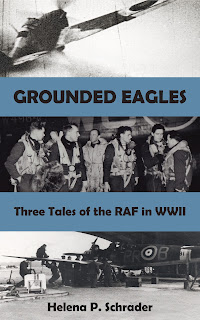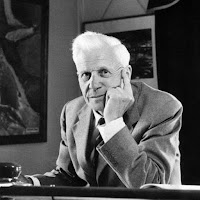A Remarkable Kind of Hero : The Engineer Barnes Wallis
It is extremely rare for an engineer to become a celebrity. Rulers and politicians, conquerors and prophets fill the history books. Explorers and adventurers sometime become famous, while artists, authors, musicians and actors occasionally gain widespread recognition or, in exceptional cases, superstar status. Yet engineers? Engineers are by nature modest and practical men (and women), more focused on the seemingly pedestrian problems of building practical things. Yet, the name of one engineer has been remembered for his contributions to the Allied victory over Nazi Germany:
Barnes Wallis
While Wallis' fame can be traced back to the invention of the bouncing bombs used in the daring raid on the Ruhr Dams in May 1943 -- or more rather the popular 1955 film "The Dam Busters" that depicted that operation, Wallis was involved in many more innovative and successful projects. His curiosity and inventiveness encompassed a wide range of fields. According to the Barnes Wallis Foundation:
Wallis’ life was not only centred around aeronautics and aerial warfare but also included significant contributions to medical science, education, maritime engineering, astronomy and other areas. Wallis participated in the development of radio telescopy and nuclear submarines, pioneered work in the de-icing of trawlers, and gave much time and money to educational advancement and to charity.
“I have found that the more opposition and the more criticism that one gets, the more one has to perfect one’s idea in putting it forward and half the joy in life consists in the fight not in the subsequent success…. I think you have got to be tough."
In 1908, Wallis moved to the J.S. White shipyard in Cowes, Isle of Wight, where he was involved in the design of torpedo boats and destroyers. Although he did very well, he seized an opportunity to transfer from marine to aeronautical engineering, when a job offer from Vickers-Armstrongs landed on his desk in 1913.
Here he became involved in developing designs for rigid airships. In 1915, however, the First Lord of the Admiralty Winston Churchill stopped all work on the airship Wallis was designing under the direction of Hartley Pratt. Both men promptly enlisted. Nine months later, a new First Lord of the Admiralty wanted the work to resume on rigid airships and Pratt and Wallis were released from the army and sent back to the drawing boards, designing airships.
This work continued throughout the war and afterwards until 1930, with the focus naturally shifting from military to civilian uses in the post-war era. A civil airship designed under Wallis' guidance, the R100, made its maiden crossing from the UK to Montreal in Canada in just 78 hours and 49 minutes and the return flight (with the winds) in 57 hours 56 minutes -- far faster than contemporary ocean liners. But safety issues continued to plague airships, and in 1931 the R100 was grounded.
Meanwhile, in 1922, Wallis had earned an engineering degree via the University of London's External Programme, and in 1925 he married. With the future of airships looking dim, Vickers-Armstrongs directed Wallis' talents toward fixed-wing aircraft. Here he applied what he had learned about streamlined fuselage construction for airships to winged aircraft, developing what became known as geodesic design. Rather than a wooden framework on which canvas or metal was tacked, metal struts were interwoven more like a loose basket producing curving surfaces. Geodesic design produced lighter but remarkably strong aircraft, which could flex and also take a great deal of punishment -- as seen below.
At the outbreak of the war, however, Wallis' two aircraft were already deployed with squadrons, the design phase over. Wallis found himself wondering what he -- as an engineer -- could do to shorten a war that he knew would be horrible. At this stage in his life, Wallis was already 52 and recognized as one of the leading aircraft designers of his generation. Freed from work on any specific project, he started to experiment with a variety of ideas. No longer tied to government specifications, his imagination took flight, and while many of his ideas were dismissed by contemporaries as impractical if not ridiculous, Wallis' philosophy (as noted above) was to see criticism as a stimulus to keep perfecting an idea.
He also spent time studying the industrial capacity of Germany and seeking vulnerabilities. He was particularly keen to identify targets whose elimination would have a domino or knock-on effect beyond the loss of the target itself. His research led him to the Ruhr dams. These were a lynch-pin providing electricity to countless armaments factories in the region and water for steel production, both of which would also be disrupted if the dams were destroyed. Finally, the flood waters from the broken dams would cause extensive damage.
Just three weeks later the specially formed 617 Squadron took the bombs to the Ruhr and destroyed two of the three target dams and damaged the third -- for the loss of 8 out of 17 aircraft. Post-war pundits have belittled the achievement, saying German industry was soon back at full capacity, but the German Minister of Armaments viewed the attack as shocking and devastating. He also noted that if the English and systematically followed through with more attacks against these and other dams in the region, the German steel industry would have collapsed. For whatever reasons, the British did not.
Meanwhile, the success of the bouncing bomb convinced the Air Ministry to trust Barnes Wallis with the development of more ordinance. Wallis wanted more "bang for the buck" and worked out that the optimal bomb would weight ten tons (22,000 lbs) and be dropped from 40,000 feet. However, there was no aircraft in existence that could lift that load that high. So, Wallis revised his expectations downwards to a 12,000 lb bomb that could be dropped from 18,000. The "Tallboy" was born.
The successful deployment of the Tallboys encouraged the Air Ministry to authorize development work the ten-ton bomb, the "Grand Slam." Only by removing the bomb-bay doors altogether and the foreword and mid-upper turrets was it possible for the Lancaster to carry a single one of these gigantic bombs. Even so, with this load the Lancaster could not fly higher than 18,000 feet, so the results were not optimal -- but good enough. With these bombs the Lancasters of 617 and 9 squadron struck and destroyed hardened targets such as U-boat and E-boat pens and the factory in which super-submarines capable of underwater speeds in excess of 20 knots were being built. These weapons undoubtedly helped win and shorten the war, although not by as much as Wallis had envisaged or hope at the start.
He was haunted somewhat by the terrible death toll of the Dambusters raid, both among the aircrew and those caught in the tsunami effect of the breached dams. To this end Wallis, wherever possible, made radio controlled models of his designs, so as not to risk the lives of test pilots. Wallis also donated his £10,000 prize from the Royal Commission on Awards to Inventors to Christ’s Hospital School in 1951 to allow them to set up the RAF Foundationers’ Trust, which allows the children of RAF personnel killed or injured in action to attend the school.
He plays a cameo role in my novel "Moral Fibre," which like all my novels about the RAF in WWII are intended as tributes to the men in the air and on the ground that made a victory in Europe against fascism possible.
Riding the icy, moonlit sky,
they took the war to Hitler.
Their chances of survival were less than fifty percent.
Their average age was 21.
This is the story of just one bomber pilot, his crew and the woman he loved.
It is intended as a tribute to them all.
or Barnes and Noble.

"Where Eagles Never Flew" was the the winner of a Hemingway Award for 20th Century Wartime Fiction and a Maincrest Media Award for Military Fiction. Find out more at: https://crossseaspress.com/where-eagles-never-flew
For more information about all my aviation books visit: https://www.helenapschrader.com/aviation.html











Comments
Post a Comment